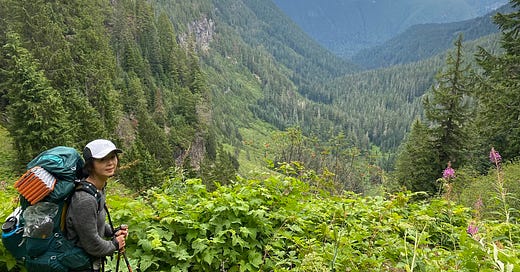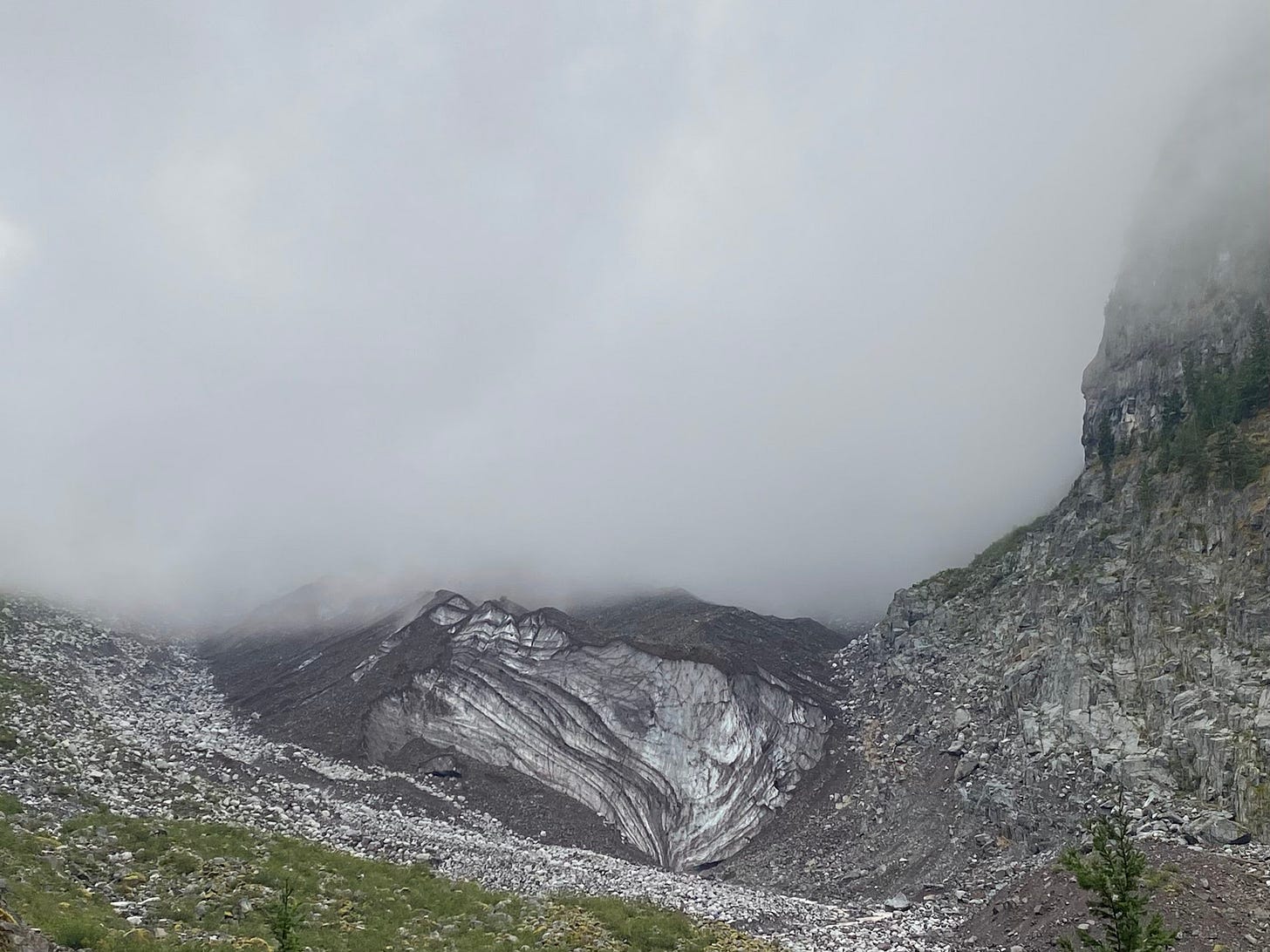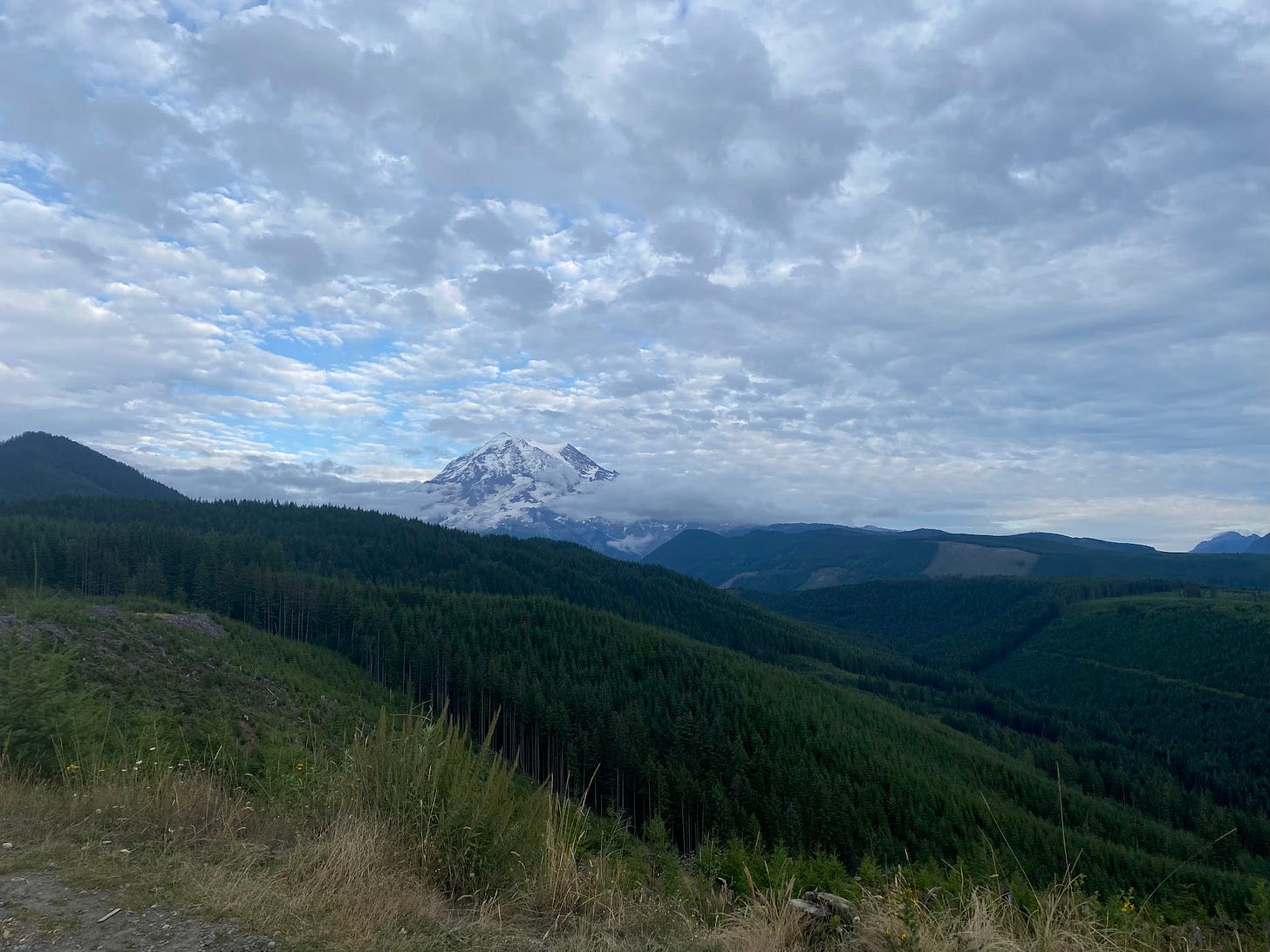The Weight of Water: Hiking (part of) the Wonderland Trail
Sipping glacial oolong on Mt. Rainier
“If I did that, I’d be dead.”
We were in the lobby of the Econo Lodge in Buckley, WA, a 93% white town of 5,000 near Mt. Rainier, known for hosting The Buckley Log Show. We had just come from 3 days of backpacking around part of the Wonderland Trail, and gave the curly-haired, 50-something clerk a synopsis while she checked us in.
“I’m too old for that kind of thing, I’d die,” she shuddered.
We smiled politely and gently assured her it was worthwhile.
“Well, but good for you,” she added, hastily.
As she clicked and clacked, I scanned the lobby. There was an oil-painting inspired print of Mt. Rainier over a walkway, and a shrine to Ganesh above the sliding glass door. Indians own most motels in America—a plaque by the counter said it was managed by RAJ&ASSOCIATES.
The water from the iced cooler tasted awful.
Hiking to a glacier, especially after descending a Mordor-esque cliff through a lush valley filled with giant ferns and dribbling streams, is a magical experience. The weight of our packs only elevated the memorableness of the journey. Within the massive undulations of Mt. Rainier, one of the tallest and most glaciated peaks in North America there are many hidden places of peace, stillness/motion, and beauty: rushing water, reflections of green light off ferns, the clouds dancing above us.
Everyone who does a section of the Wonderland, like all National Park Service (NPS) backcountry sites, has to get a permit. This reduces the flow of people, protects the ecosystems, and helps retain a wilder feeling. Despite permit quotas, as well as additional new restrictions to ease the flow of people (leading to an additional 40% increase in visitors in the past 10 years), we saw very few people. Good job, park service!
The previous summer, we had done a section of the Wonderland on the drier, eastern side of Rainier, an exhilarating 10 mile loop, 1000 meters up and down narrow cliffs and alpine ecosystems. Along one isolated stretch, a puckering marmot stood up on a nearby rock. We hung back in silence, watching it, when out of nowhere, a sound like a drone gusted over our head, and the marmot dived for cover—an eagle screamed by so closely, we could feel the wind above our heads.
The next morning at White River Campground, a massive thunderstorm erupted as suddenly as that hungry eagle’s descent. We raced to the awning of the primitive shelter with our teaware, boiling, brewing, and sipping, by flurries of rain and thunder that crackled deeper than any bass drum. An eager crowd of young folks in ponchos waited out the storm with cheerful anticipation—most likely, to start their entire 9 day trek (approximately 93 miles and 34K feet of total elevation change) around the 3rd tallest mountain in North America.
These memories were with me as we waited to start our modest 3 day trip. At the info board at the ranger’s station, the road to Mowich Lake read: 15 miles of mud, misery, and potholes.
An hour later, with our hardworking Toyota Camry still in one piece, I agreed with the Park Service’s assessment. As we were having our pre-hike in tea by the campsite cum trailhead, a suitably relaxed young hippie-looking couple walked by, asking if we had seen a ranger recently. They had just finished the entire Wonderland Trail and were looking for the rest of their food cache (on trails that take longer than 5 days to complete, it’s typical to send food packages to yourself at designated pickup locations).
“I’m jealous! How was it?” I said, in good spirits.
“Well,” said the woman, “it rained 4 out of the 9 days,” looking a bit fatigued.
“But it was still great,” added her partner, to keep the mellow vibes going.
“Do you think it would have been better to do it earlier in the year?”
“Well,” she said thoughtfully, “the mountain makes its own weather.”
Ipsut Creek is not a popular campground.
The large, numbered sites are mostly deserted when we arrive on a Monday evening, after 5 hours of trudging down the cliffs with our packs, and through the valleys and streams. As usual, we were nourished along the way by quality 100 % cacao, energy bars, hard boiled eggs, and a little bag of salt to replace lost electrolytes.
Finally arriving, it seems surprising that there should be proper outhouses, with “proprietary composting technology,” in this hike-in campsite—something missing in the Olympics—but it’s a reminder that Rainier is a much more popular destination because of, rather than in spite of its much steeper topography.
The Carbon River is close to the campground, but not easily accessible, and as I quickly learned, the water from it is very silty. This put a strain on my filter, and didn’t taste great. The thing to do is to walk back 1/4 mile on the trail, and filter from a stream running down from a waterfall. This water is cold, deep, refreshing, and sweet—wonderful, like all unadulterated glacial water sources.
To reduce the number of water-carrying trips, we hatched a plan—unload all our food from the bear canister into the on-site bear locker, and fill the canister with water—all 11.7 liters of it. It’s a little crazy, but I have to admit, still more appealing than making a bunch of trips. And who do you think got to carry that 12 L container of water?
That night, my clothes were still damp from hauling a 29 lb not-leak-proof container around my arms like a precious fat baby for 1/4 of a mile. Of course, there was no sun in sight.
In the morning, as it started to rain—déjà vu—we moved to the side of the nearby shelter, with our teaware, the only ones around. Earlier in the month, I had bought some Taiwanese high mountain oolong tea from Pear Mountain (LiShan), the sort I used to drink all the time when I lived in Taipei. Good Taiwanese oolong is never cheap, but when it’s good, it’s great. I had procured the 100 g bag from my local dealer, but in truth, it left me a bit disappointed.
It certainly had the characteristic floral aroma and distinctive round taste Taiwanese oolongs are known for, but it still felt somewhat flat. It was the tea-equivalent of hiking up a tall summit, but without finding a clear viewpoint; satisfying, but not majestic.
However, knowing how good this water tasted on its own, I was curious to see how it would change the tea. As the rain dripped down around us, and I retrieved my boiling water from the camping stove, I made the first brew. The taste was indescribable.
It was almost like a different tea—bursting with a deep-lingering aroma, and a complexity that had previously been absent. Water really is the mother of tea—and of us all. That complex, ancient mixture of unpolluted water from these towering glaciers had completely transformed my humble rolled tea, brewed in a camping cup, into The Dragon of all Oolongs.
After a couple mornings of this, I never wanted to drink a high mountain oolong again if the water wasn’t glacial water. No matter how much money you spend, or how many crazy filtering devices you have, this experience just can’t be replicated any other way.
I miss being able to pee anywhere.
Hiking to the glacier, we encountered almost nobody, except a hard-eyed couple that appeared to be doing the full circuit, and forging ahead in grueling silence. We saw some bear scat, and then embarked on one of many unnerving river crossings, each seemingly more precarious than the last.
They were more or less, logs with a few carved notches, and the last was an elevated plank with a one-sided hand rail and irregular slats. The perpendicular rushing of the grey-brown currents, as we walked across slowly, gave a sense of vertigo, and the freeze response was a real risk.
After making our last crossing, and slowly ascending up the other side of the valley, Cathy was grumbling and getting worried about the eventual fading light, but I told her that we have to make it to the glacier, that it will give us the necessary manna to return.
Finally, after multiple jumbles of rocks, we arrived at the viewpoint. As with proximity to many glaciers, the air was all cold mist and swirling clouds, a suitable eternal icy-Mt. Doom backdrop to match the vast, wild remoteness of this feeling.
The Carbon Glacier is chopped up and dirty, like a giant child came along and beat it with a spoon for a few million years. But it’s still beautiful. In this ice and its runoff, there are pieces of spacetime—gases in the ice that have been trapped for millions of years, recycled, imbibed, ejected, mixed. Giant primordial slush. Like most glaciers, it is receding, but still feeding enormous rivers and creeks.
Exiting the trailhead on the 3rd day, the campsites at Mowich Lake seemed too packed together after our isolation. We decided to head back down the mountain to investigate a dispersed campsite by the Carbon River I had previously looked up, outside the park. But not before getting some epic views of the giant, whose mere toes we had been traversing around.
The dispersed camping site, outside the bounds of Mt. Rainier National Park, turned out to be a bumpy dirt track along a section of the Carbon River.
Cars and RVs of mostly men, who are most likely not backpackers. Trucks, barbecues, dogs, big plastic water jugs—no one here is filtering their own water.
While we tried to figure out if we could even get our car down the rocky path—blocked by an RV—I went to filter more water. It was the same silty water, but in a more industrial area—remnants of old fires, trash, and a discarded floating sign. Sadness.
As we were deciding whether to stay the night in this hovel, a large man with long hair walked by and encouraged us.
“You can make it! It’ll mess up the underside of your car some, but you can do it.”
We talked for a bit. He was slightly slovenly, but good-natured and friendly, something I always appreciate after living in Canada.
“What part of BC you from?” he asked, glancing at our plates.
“Vancouver! I have some relatives there..but I haven’t been over there in a long time. I love those Nanaimo bars.”
“That’s a real place,” I added, “it’s a city on Vancouver island, that’s what they’re named after.”
“Oh, I know,” as he continued with his gastronomical memory,
“you can only get the ketchup-flavored Lays over there now..but—I’m cutting down on my sugar",” he added, reassuringly.
Americans are always reassuring each other of something.
We drove over to a picnic area on the edge of the park entrance, while we decided what to do. As we started to cook our dinner, the misty slopes around the river gradually gave way to the usual monolithic darkness. As the last slivers of grey from the sky were slurring away, a U-Haul truck suddenly pulled up to the small parking area.
Was this a mirage? I never expect to see a moving truck on the edge of a remote national park—we weren’t anywhere near anything that could be called a main road. Its small lights seemed like glowing beacons in the darkness.
As we peered over our rice noodles and tofu with headlamps, wondering what would happen next, a middle-aged man got out of the car, wearing only a t-shirt. I could just barely make out the BLACK LIVES MATTER insignia. Then, he went around the back of the truck and lifted up the sliding door, and one by one, 1, 2, 3, 4, children and teenagers got out of the back. A visibly pregnant woman got out of the passenger door.
The weather was the same it had been every night—cold and damp—but the kids were only wearing t-shirts, or at most, thin jackets. If they were moving, I couldn’t see a single piece of furniture, or much in the way of luggage.
They all milled around for a bit with ordinary flashlights, easily swallowed up by the immense darkness of the adjacent rainforest, and made a beeline for the nearby day-use bathroom (still open). The kids all seemed semi-spooked by the remoteness of their rest stop, but if the dad felt anything, he didn’t show it.
Eventually, they all filed back in, and after a few minutes, the lights went dark. So they were sleeping here, in the day use parking area—illegally—but I also hadn’t seen anything that resembled a bed, a sleeping pad, or a sleeping bag. I briefly thought about giving them something from our supplies, but I wasn’t sure what, and I didn’t want to intrude on their “family trip.”
You’ll never see this in Canada, I thought to myself, or probably anywhere else in the so-called developed world.
And so we left the dispersed camping by the Carbon River of Mt. Rainier National Park, National Forest and adjacent wilderness collective areas. We descended down the slopes of the colossus, and once we got signal half an hour or so later, found a cheap place to spend the night—The Econo Lodge of Buckley.
Taking showers late at night, we unravelled from exhaustion with the usual bursts of pointless anger that come with the transition from wild, grueling nature, to mundane, bland, cushiness.
“Where’s the floss?”
“You have it!”
“No, you have it!”
Our cares evaporating with the novelty of cleanliness, we devoured each other hungrily, as just-baked croissants. When you’re in your 20s, you can do this at any time. When you’re 40, and have been in a relationship for 10 years, suffering and being wild in nature together through hiking, water-filtering, and the unknown, are as good an aphrodisiac as diamond-encrusted handcuffs.
The next day, on the way to Portland, we stopped in a large park in the city of Puyallup, WA. As we sat under a large verandah, drinking tea made with terrible Econo Lodge cooler water, we watched local kids run barefoot, up and down the dirt paths of a gully. A small stream flowed through it.
It would have been better to take the water from here, I thought to myself, and then, I’ll never be able to match the people who grow up in this kind of environment, never.







“I miss being able to pee anywhere.” Haha…you wouldn’t miss it so much if you had to squat as low as possible to avoid pissing on your feet. The glacier water sounds lovely though.
"I miss being able to pee anywhere". You can go to Vietnam where many people pee on streets 😄